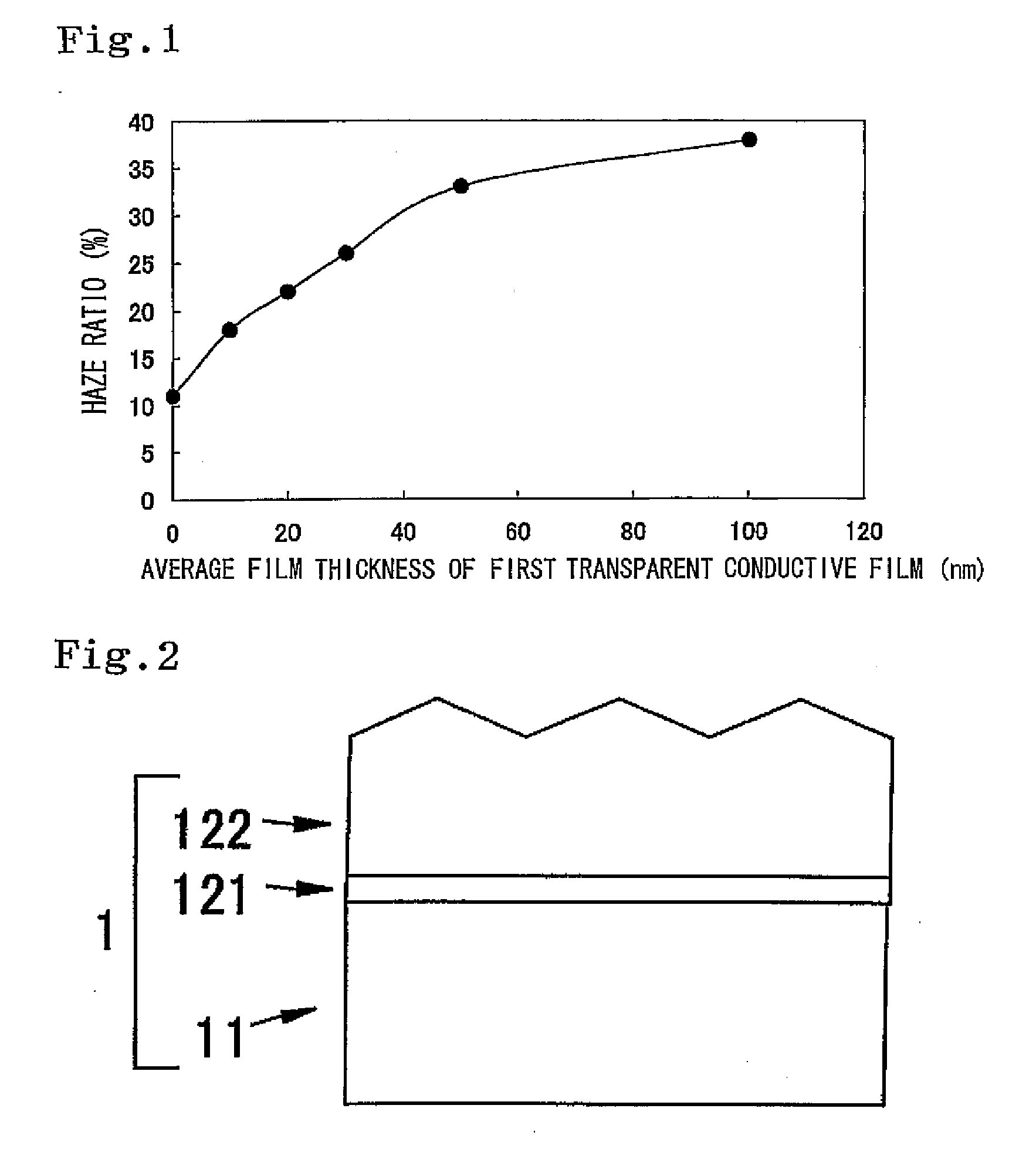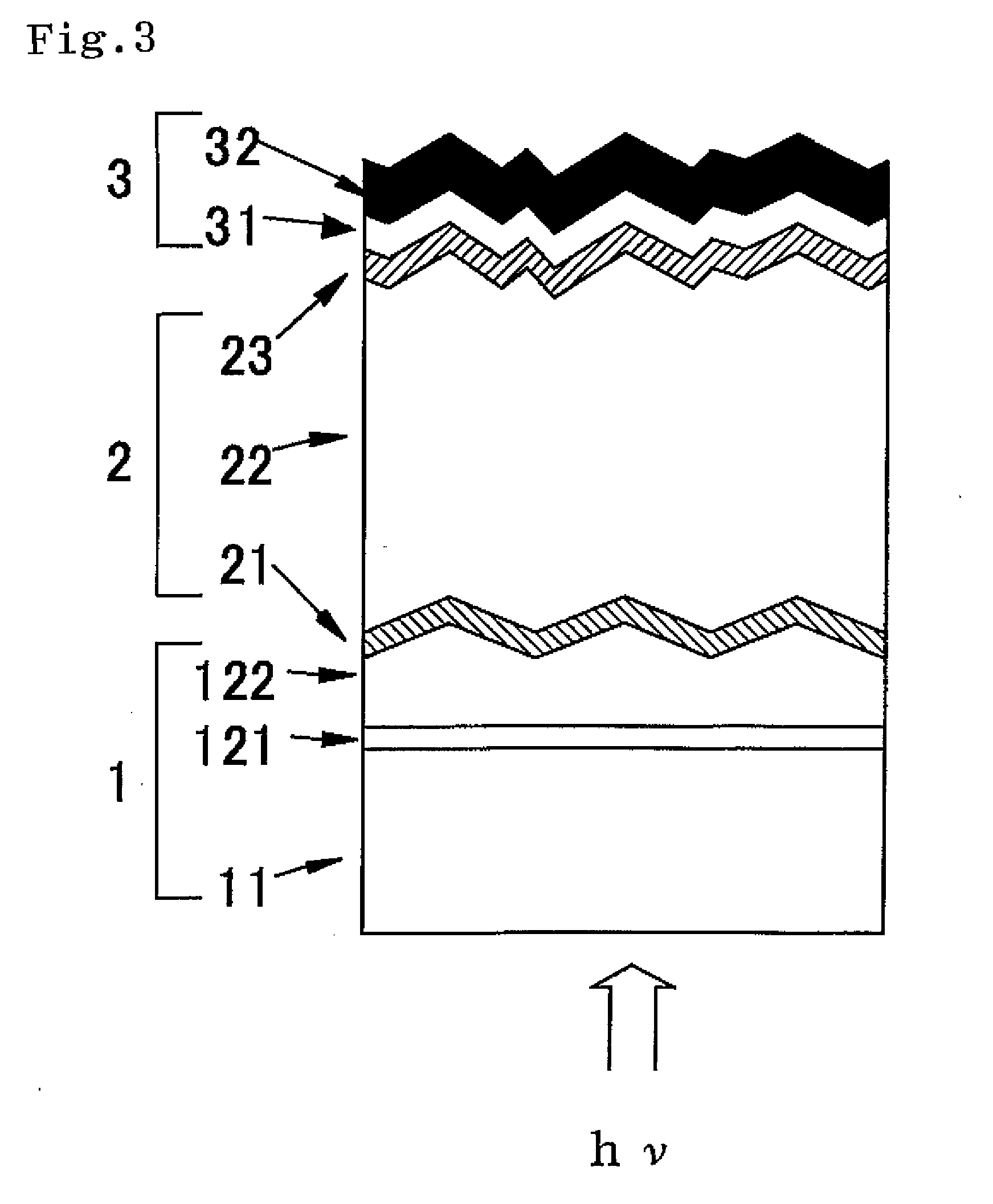Substrate Provided with Transparent Conductive Film for Photoelectric Conversion Device, Method for Manufacturing the Substrate, and Photoelectric Conversion Device Using the Substrate
- Summary
- Abstract
- Description
- Claims
- Application Information
AI Technical Summary
Benefits of technology
Problems solved by technology
Method used
Image
Examples
example 1
[0057]As Example 1, a substrate 1 provided with a transparent conductive film for a photoelectric conversion device such as shown in FIG. 2 was fabricated.
[0058]As the transparent insulating substrate 11, a glass plate having a thickness of 0.7 mm with 125 mm square was used, and Al-doped ZnO was formed to a thickness of 10 nm thereon as the first transparent conductive film 121 by the sputtering method. In forming the first transparent conductive film 121, the substrate temperature was set to be 250° C.; a 3%-Al-doped ZnO with 10-inch (diameter of 254 mm) φ was used as a target; and a condition of the RF power of 400W under an Ar gas atmosphere was used. The haze ratio as measured by the haze meter with use of a D65 light source on the obtained substrate provided with the first transparent conductive film made of the ZnO film was 0.2%. Subsequently, as the second transparent conductive film 122, B-doped ZnO was formed to a thickness of 1.1 μm by the low-pressure CVD method. This se...
example 2
[0060]In Example 2, a substrate 1 provided with a transparent conductive film for a photoelectric conversion device was fabricated in the same manner as in Example 1. However, the difference from Example 1 lies in that the thickness of the first transparent conductive film 121 was set to be 20 nm. The substrate 1 provided with the transparent conductive film for the photoelectric conversion device obtained under this condition had a sheet resistance of about 12 Ω / □ and a haze ratio of 22%. Also, the total light transmittance of the obtained substrate 1 provided with the transparent conductive film for the photoelectric conversion device was measured by allowing light to be incident from the glass plate side with use of a spectrophotometer. It showed a light transmittance of 80% or more within a wavelength range of 400 to 1200 nm.
example 3
[0061]In Example 3, a substrate 1 provided with a transparent conductive film for a photoelectric conversion device was fabricated in the same manner as in Example 1. However, the difference from Example 1 lies in that the thickness of the first transparent conductive film 121 was set to be 30 nm. The substrate 1 provided with the transparent conductive film for the photoelectric conversion device obtained under this condition had a sheet resistance of about 10 Ω / □ and a haze ratio of 26%. Also, the total light transmittance of the obtained substrate 1 provided with the transparent conductive film for the photoelectric conversion device was measured by allowing light to be incident from the glass plate side with use of a spectrophotometer. It showed a light transmittance of 80% or more within a wavelength range of 400 to 1200 nm.
PUM
| Property | Measurement | Unit |
|---|---|---|
| Thickness | aaaaa | aaaaa |
| Thickness | aaaaa | aaaaa |
| Thickness | aaaaa | aaaaa |
Abstract
Description
Claims
Application Information
 Login to View More
Login to View More - R&D
- Intellectual Property
- Life Sciences
- Materials
- Tech Scout
- Unparalleled Data Quality
- Higher Quality Content
- 60% Fewer Hallucinations
Browse by: Latest US Patents, China's latest patents, Technical Efficacy Thesaurus, Application Domain, Technology Topic, Popular Technical Reports.
© 2025 PatSnap. All rights reserved.Legal|Privacy policy|Modern Slavery Act Transparency Statement|Sitemap|About US| Contact US: help@patsnap.com



